
Burgundy wine is made in the Burgundy region of eastern France, in the valleys and slopes west of the Saône, a tributary of the Rhône. The most famous wines produced here, and those commonly referred to as "Burgundies", are dry red wines made from pinot noir grapes and white wines made from chardonnay grapes.
First Growth status is a classification of wines primarily from the Bordeaux region of France.

Clos de Vougeot, also known as Clos Vougeot, is a wall-enclosed vineyard, a clos, in the Burgundy wine region, and an Appellation d'origine contrôlée (AOC) for red wine from this vineyard. It was named for the River Vouge, which is in fact only a stream separating the village Vougeot from Chambolle-Musigny. At 50.6 hectares, Clos de Vougeot is the largest single vineyard in Côte de Nuits entitled to the grand cru designation, while Corton in Côte de Beaune is the largest grand cru in Burgundy as a whole.

Bordeaux wine is produced in the Bordeaux region of southwest France, around the city of Bordeaux, on the Garonne River. To the north of the city, the Dordogne River joins the Garonne forming the broad estuary called the Gironde; the Gironde department, with a total vineyard area of 110,800 hectares, is the second largest wine-growing area in France behind the Languedoc-Rousillon.

The Côte de Nuits is a French wine region located in the northern part of the Côte d'Or, the limestone ridge that is at the heart of the Burgundy wine region. It extends from Dijon to just south of Nuits-Saint-Georges, which gives its name to the district and is the regional center. Though some white and rosé wines are produced in the region, the Côte de Nuits is most famous for reds made from pinot noir. The Côte de Nuits covers fourteen communes. Six produce grand cru wines, in the central district between Gevrey-Chambertin and Nuits-Saint-Georges, with four lesser villages either side. The Grand Crus of the Côte de Nuits are some of the smallest appellations in France, less than a hectare in the case of La Romanée.

In 1955, the wines of Saint-Émilion in the wine-growing region of Bordeaux were classified. Unlike the Bordeaux Wine Official Classification of 1855 covering wines from the Médoc and Graves regions, the Saint-Émilion list is updated every 10 years or so. Following the initial classification, the list was updated in 1969, 1986, 1996, 2006, 2012, and 2022. However the 2006 classification was declared invalid following a series of legal actions, and the 1996 version of the classification has been reinstated for the vintages from 2006 to 2009.

Côte Chalonnaise is a subregion of the Burgundy wine region of France. Côte Chalonnaise lies to the south of the Côte d'Or continuing the same geology southward. It is still in the main area of Burgundy wine production but it includes no Grand cru vineyards. Like the Côte d'Or, it is at the western edge of the broad valley of the river Saône, on the rising ground overlooking the town of Chalon-sur-Saône which is about six kilometers out into the plain. To the north, across the River Dheune, lies the Côte de Beaune. To the south is the Mâconnais. The grapes of the region are predominantly Pinot noir and Chardonnay with some Aligoté and Gamay also grown in vineyards spread over a stretch of 25 kilometers long and 7 kilometers wide of undulating land in which vineyards are interspersed with orchards and other forms of farming.
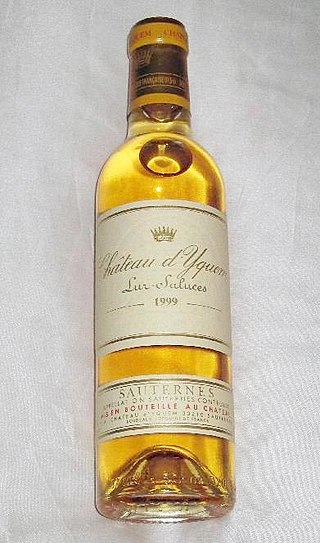
Sauternes is a French sweet wine from the region of the same name in the Graves section in Bordeaux. Sauternes wine is made from Sémillon, sauvignon blanc, and muscadelle grapes that have been affected by Botrytis cinerea, also known as noble rot. This causes the grapes to become partially raisined, resulting in concentrated and distinctively flavored wines. Due to its climate, Sauternes is one of the few wine regions where infection with noble rot is a frequent occurrence. Even so, production is a hit-or-miss proposition, with widely varying harvests from vintage to vintage. Wines from Sauternes, especially the Premier Cru Supérieur estate Château d'Yquem, can be very expensive, largely due to the very high cost of production. Barsac lies within Sauternes and is entitled to use either name. Somewhat similar but less expensive and typically less-distinguished wines are produced in the neighboring regions of Monbazillac, Cérons, Loupiac and Cadillac. In the United States, there is a semi-generic label for sweet white dessert wines known as sauterne without the "s" at the end and uncapitalized.
The glossary of wine terms lists the definitions of many general terms used within the wine industry. For terms specific to viticulture, winemaking, grape varieties, and wine tasting, see the topic specific list in the "See also" section below.
Château Angélus, until 1990 known as Château L'Angélus, or simply L'Angélus, is a winery in the Right Bank of the Bordeaux wine region, in the appellation of Saint-Émilion. The estate was formerly highly ranked in the Classification of Saint-Émilion wine, being promoted to Premier grand cru classé in 1996, then Premier grand cru classé (A) in 2012, before withdrawing from the classification in 2021.
The classification of wine is based on various criteria including place of origin or appellation, vinification method and style, sweetness and vintage, and the grape variety or varieties used. Practices vary in different countries and regions of origin, and many practices have varied over time. Some classifications enjoy official protection by being part of the wine law in their country of origin, while others have been created by, for example, growers' organizations without such protection.

The wine regions of Bordeaux in France are a large number of wine growing areas, differing widely in size and sometimes overlapping, which lie within the overarching wine region of Bordeaux, centred on the city of Bordeaux and covering the whole area of the Gironde department of Aquitaine.
Château Pavie-Macquin is a Bordeaux wine from the appellation Saint-Émilion, ranked Premier grand cru classé B in the Classification of Saint-Émilion wine. The winery is one of three Pavie estates, along with Château Pavie and Château Pavie-Decesse, located in the Right Bank of France’s Bordeaux wine region in the commune of Saint-Émilion in the department Gironde. Having risen in esteem in the 1990s, it was promoted to Premier Grand Cru Classé in 2006.

Provence (Provençal) wine comes from the French wine-producing region of Provence in southeast France. The Romans called the area provincia nostra, giving the region its name. Just south of the Alps, it was the first Roman province outside Italy.
Château Beau-Séjour Bécot, formerly Château Beauséjour-Dr-Fagouet, is a Bordeaux wine from the appellation Saint-Émilion, ranked Premier grand cru classé B in the Classification of Saint-Émilion wine. The winery is located in the Right Bank of France's Bordeaux wine region in the commune of Saint-Émilion, in the department Gironde.
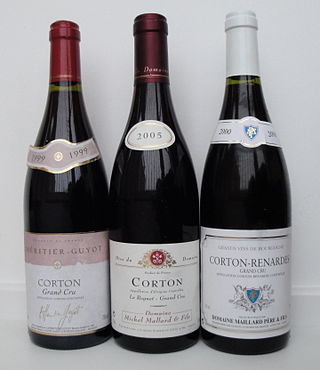
Lieu-dit is a French toponymic term for a small geographical area bearing a traditional name. The name usually refers to some characteristic of the place, its former use, a past event, etc. A lieu-dit may be uninhabited, which distinguishes it from an hameau (hamlet), which is inhabited. In Burgundy, the term climat is used interchangeably with lieu-dit.
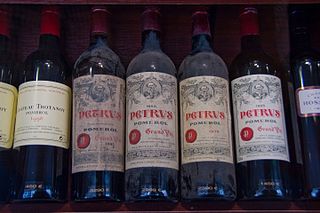
Pomerol is a French wine-growing commune and Appellation d'origine contrôlée (AOC) within the Libournais in Bordeaux. The wine produced here is predominately from Merlot with Cabernet Franc playing a supporting role. Unlike most other Bordeaux communes, there is no real village of Pomerol, although there is a church. The houses are set among the vineyards.
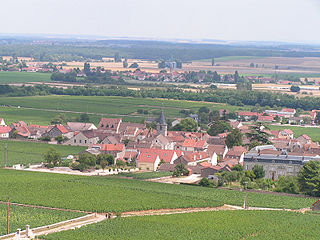
Vosne-Romanée wine is produced in the commune of Vosne-Romanée in Côte de Nuits of Burgundy as well as in the neighbouring commune of Flagey-Échezeaux. The Appellation d'origine contrôlée (AOC) Vosne-Romanée may only be used for red wine with Pinot noir as the main grape. There are a total of 15 Premier Cru vineyards in the two communes, as well as six Grand Cru vineyards in Vosne-Romanée and two in Flagey-Échezeaux. These Grand Cru vineyards include Burgundy's most iconic, sought-after and expensive red wines, with Romanée-Conti of Domaine de la Romanée-Conti at the pinnacle: "There can be little doubt that in the firmament of the Cote de nuits, Vosne-Romanée is the brightest star."
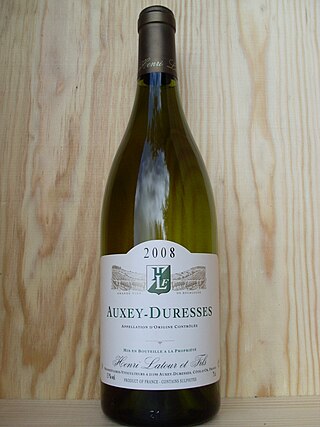
Auxey-Duresses wine is produced in the commune of Auxey-Duresses in Côte de Beaune of Burgundy. The Appellation d'origine contrôlée (AOC) Auxey-Duresses may be used for red and white wine with respectively Pinot noir and Chardonnay as the main grape variety. The production consists of around two-thirds red wine, and one-third white wine. There are no Grand Cru vineyards within Auxey-Duresses. The AOC Auxey-Duresses was created in 1970. Before the introduction of the appellation system in the 1930s, wines from this village were probably sold under the names of the more famous neighbors Volnay and Meursault. Later, the wines have been sold as Côte de Beaune-Villages, but it has progressively become more common to actually use the Auxey-Duresses AOC for the wines.

Saint-Émilion is an appellation d'origine contrôlée (AOC) for wine in the Bordeaux wine region of France, where it is situated in the Libourne subregion on the right bank of the Dordogne. As a cultural landscape demonstrating a long, living history of wine-making, Saint-Émilion was registered as a UNESCO World Heritage Site in 1999.
![A blanc de blancs [fr] Champagne made 100% from Chardonnay Blanc de blanc grand Cru champagne.jpg](http://upload.wikimedia.org/wikipedia/commons/thumb/6/6c/Blanc_de_blanc_grand_Cru_champagne.jpg/220px-Blanc_de_blanc_grand_Cru_champagne.jpg)
![A French Grand Cru Champagne from the village of Ambonnay, a Bernard Bremont Millesime [fr] 2004 Grand Cru champagne 2.jpg](http://upload.wikimedia.org/wikipedia/commons/thumb/a/a2/Grand_Cru_champagne_2.jpg/220px-Grand_Cru_champagne_2.jpg)












